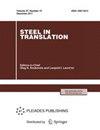液态钢中的氧化铝结晶
Q4 Materials Science
引用次数: 0
摘要
摘要溶解氢在液态钢中氧化铝微晶的形成过程中起到解调作用。液态钢中的氢原子是氧化铝微晶的表面活性元素。改性剂可大大降低钢液中的氢浓度。这就加强了氧化铝微晶凝结成大颗粒的过程,使其迅速漂浮在钢液中。为了更有效地去除钢液中的氧化铝微晶,在使用改性剂处理钢液后,不应立即开始浇铸工艺。本文章由计算机程序翻译,如有差异,请以英文原文为准。
Crystallization of Aluminum Oxide in Liquid Steels
Abstract
Dissolved hydrogen acts as a demodifying element in the formation of aluminum oxide microcrystals in liquid steels. Hydrogen atoms in liquid steels serve as surface-active elements for aluminum oxide microcrystals. Modifiers significantly reduce the hydrogen concentration in steel melts. This enhances the process of coagulation of aluminum oxide microcrystals into large particles that quickly float in liquid steels. To more effectively remove aluminum oxide particles from them, the casting process should not begin immediately after treating steel melts with modifiers.
求助全文
通过发布文献求助,成功后即可免费获取论文全文。
去求助
来源期刊

Steel in Translation
Materials Science-Materials Science (all)
CiteScore
0.60
自引率
0.00%
发文量
81
期刊介绍:
Steel in Translation is a journal that represents a selection of translated articles from two Russian metallurgical journals: Stal’ and Izvestiya Vysshikh Uchebnykh Zavedenii. Chernaya Metallurgiya . Steel in Translation covers new developments in blast furnaces, steelmaking, rolled products, tubes, and metal manufacturing as well as unconventional methods of metallurgy and conservation of resources. Papers in materials science and relevant commercial applications make up a considerable portion of the journal’s contents. There is an emphasis on metal quality and cost effectiveness of metal production and treatment.
 求助内容:
求助内容: 应助结果提醒方式:
应助结果提醒方式:


